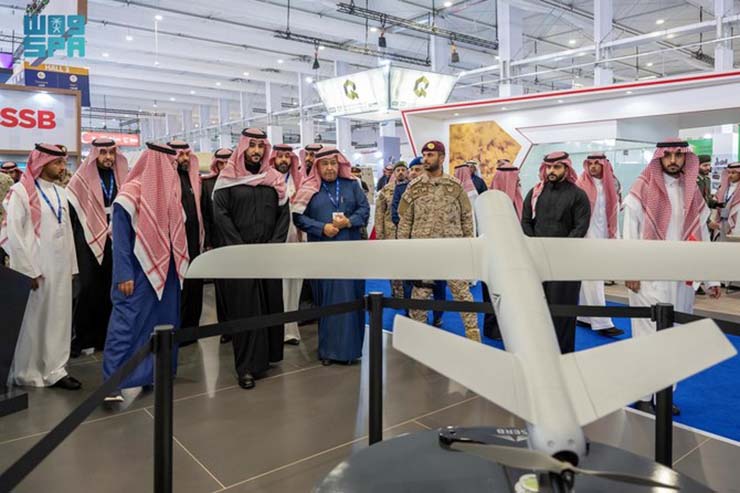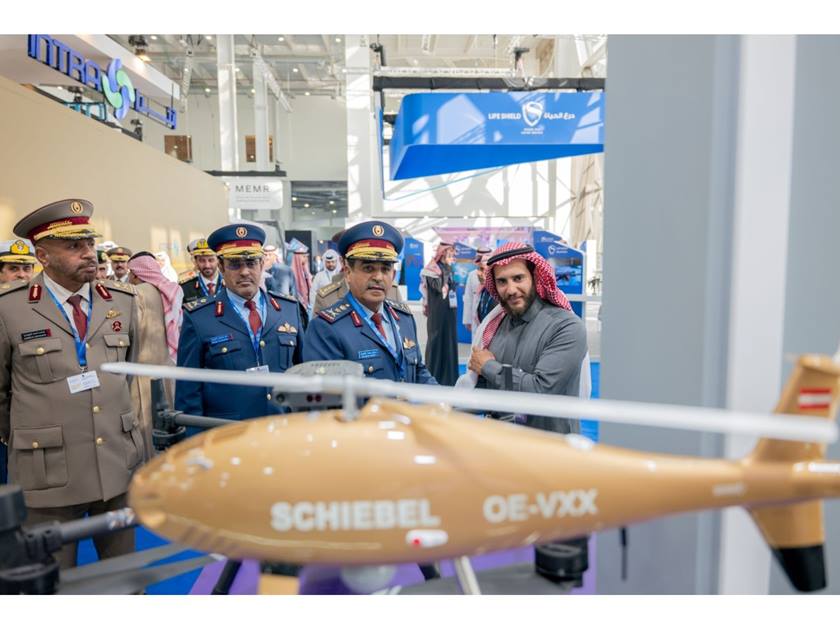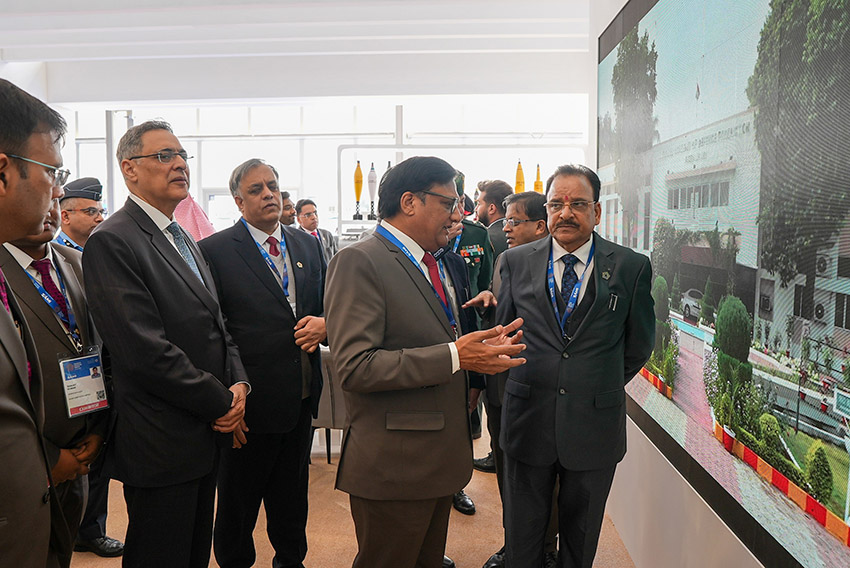
Saudi Arabia’s Crown Prince Mohammed bin Salman bin Abdulaziz Al Saud, and the Saudi Minister of Defence Prince Khalid bin Salman bin Abdulaziz inaugurated the World Defence Show (WDS) 2024 in Riyadh on February 4.
The second edition of the event, organised by Saudi’s General Authority for Military Industries (GAMI) from February 4 to 8, 2024, showcases the Kingdom’s commitment to becoming a global hub for the defence industry, in the region.
WDS 2024, features participation from over 773 exhibitors representing more than 75 countries, alongside numerous government entities and leading local and international companies in the defence and security sector.
WDS 2024, highlights the Kingdom’s strategic independence and also serves the ambitious goals of Vision 2030 which aims to localise 50% of the country’s defence expenditure. By the end of 2022, Saudi Arabia was able to increase its localisation components from 4% to 13.6%.
Vision 2030 is an ambitious and all-encompassing, government-wide push by Riyadh that began in 2016 to modernise the nation and become a “global investment powerhouse”. In the defence trade, that also means luring-in foreign investments, making more partnerships with foreign defence firms and, crucially, mandating a significant amount of domestic production for defence articles. Under this vision, Riyadh’s local defence conglomerate, Saudi Arabian Military Industries or SAMI, was founded in 2017.
Saudi Arabia’s focus on promoting local expertise in emerging defence sectors such as space warfare and drones is also on display at the WDS 2024
Over the past years, the number of foundational permits and licenses reached 477 permits for 265 companies operating in the defence industries sector, alongside the launch of over 74 investment opportunities for supply chain localisation. The sector’s contribution to the GDP is expected to reach approximately SAR 93.75 billion by 2030, with an estimated total of 40,000 direct job opportunities and 60,000 indirect job opportunities.
Saudi Arabia’s focus on promoting local expertise in emerging defence sectors such as space warfare and drones is also on display at the WDS 2024.
The five-day exhibition, being held for the second time after the inaugural event in 2022, opened on Monday with everything from stealth cruise missiles to armoured cars and models of weapon systems, missile launchers and fighter bombers packed into an 800,000-square metre venue north of the capital, Riyadh.
GAMI has so far signed 11 co-operation agreements with leading international firms with a focus on the “localisation” of Saudi defence production, according to the authority’s governor, Ahmad Al Ohali.

Brig Gen Al Ajmi, director of business development at Lockheed Martin Space in Saudi Arabia told a panel on the space domain of warfare that the kingdom is looking seriously at technology transfer and training now and all the space programmes are looking for localisation as a major requirement.
The Saudi Arabian Military Industries (SAMI), created in 2017, has set a target of 50 per cent of defence spending going to domestic producers by 2030, as part of the kingdom’s ambitious Vision 2030 plan to diversify the economy.
Boeing, the US aerospace giant, already has co-operation agreements with SAMI and GAMI, having supplied around 400 aircraft to Saudi Arabia, notably the F-15 Eagle, the backbone of the Royal Saudi Air Force.
Agreements have also been announced during the show with Leonardo of Italy, one of the world’s largest defence companies that is not American, Chinese or British.
Aside from producing fixed-wing aircraft including the Alenia C-27J Spartan cargo plane and the M-346 trainer fighter jet, Leonardo has also worked on the F-35 stealth fighter and is developing tilt-rotor aircraft that can take off vertically like helicopters.
India on its part projected Nari Shakti (woman power) on a global scale by sending a three-member delegation of women officers from the armed forces to participate in the WDS 2024
Saudi Arabia has set aside $72 billion for military expenditure this year, up from 259 billion riyals last year. The kingdom accounts for around 20 per cent of US defence companies’ overseas sales. The five biggest US companies in the sector – Boeing, Raytheon, Lockheed Martin, General Dynamics and Northrup Grumman – have a combined market capitalisation of about half a trillion dollars.
Unsurprisingly, the US has a significant presence at the World Defence Show, and one of the current symbols of its military capability – the Himars missile launcher – was also on display.
China, with two of the world’s largest arms manufacturers, Aviation Industry Corporation of China and China North Industries, also has a notable presence at the exhibition as regional power seeks to diversify its sources of military hardware in a rapidly changing geopolitical landscape.
Russia’s Rosoboronexport announced before the show that it’ll be putting on Russia’s “single exhibit” – but one double the size of Moscow’s presence in 2022 and that will feature products from more than 20 Russian firms. The state organisation said it plans to display armoured vehicles and Orlan unmanned aerial vehicles as well as transport aircraft.
The Riyadh show highlights that a number of emerging defence powerhouses are seeking to tap this market, dominated so far by a handful of countries such as China, Russia, the US and UK.
South Korea, which has recently exported its formidable K2 Black Panther tanks and K9 self-propelled Howitzers to Poland had a strong presence at the exhibition.

The UAE’s Edge, formed in 2019 to develop high-tech “sovereign capabilities for global export”, is marketing its eye-catching HT-100 and HT-750 unmanned helicopters.
Turkey’s Baykar drone company is showing its new Bayraktar TB3 aircraft carrier-compatible drone, while Ankara may export a version of its TCG Anadolu helicopter carrier, built by Sedef Shipping, that carries a complement of UAVs.
India on its part projected Nari Shakti (woman power) on a global scale by sending a three-member delegation of women officers from the armed forces to participate in the WDS 2024. The delegation aims to showcase the future of defence through technological advancements from around the world, officials said.
The Indian women officers, representing the three services, include a fighter pilot, a combat engineer, and a naval officer serving on board a warship, as per the officials.
Squadron Leader Bhawana Kanth, who flies a Sukhoi-30 fighter jet, participated in a panel discussion on ‘Investing in an Inclusive Future’ on February 7. The discussion focussed on gender diversity and the representation of women across all levels in the defence domain.
Prime Minister Narendra Modi emphasised the role of India’s women in projecting Nari Shakti and showcasing their capabilities in various fields. He made these remarks at the National Cadet Corps rally on January 27, following the impressive participation of women in the 75th Republic Day parade.
Ambassador Reema bint Bandar Al Saud, the Saudi Ambassador to the United States, in a statement emphasised the Kingdom’s commitment to fostering women’s contributions across all fields, particularly in defence and security
The pivotal role of women in global defence is a central theme of the show.
HRH Ambassador Reema bint Bandar Al Saud, the Saudi Ambassador to the United States, in a statement emphasised the Kingdom’s commitment to fostering women’s contributions across all fields, particularly in defence and security.
She highlighted the strides made under Saudi Vision 2030, which champions female empowerment and their broader inclusion in the Saudi workforce. These efforts have already paved the way for numerous success stories of women excelling in diverse roles.

Speaking about women in Defence programs, the Ambassador shared that such initiatives generate global momentum, mirroring the Kingdom’s dedication to women’s empowerment. The Women in Defence program stands as a testament to this commitment, offering a unique platform to further these achievements.
All in all, the WDS 2024, aims to strengthen the Saudi Arabia’s role as a key player in the region, marked with continuing tensions, besides furthering its ambition to become the regional leader.
The manner in which Saudi has invited major players from the UK, US besides China and Russia, highlights its priority to engage with all players without tying its programmes with any one specific. This would enable it to increase competition amongst the global players for their offerings to the country and also ensure that its localisation programme is met with success and also have an arsenal, which caters to every segment of its national defence and security.
–The writer is a political commentator based in New Delhi. He can be contacted on www.asadmirza.in. The views expressed are of the writer and do not necessarily reflect the views of Raksha Anirveda








